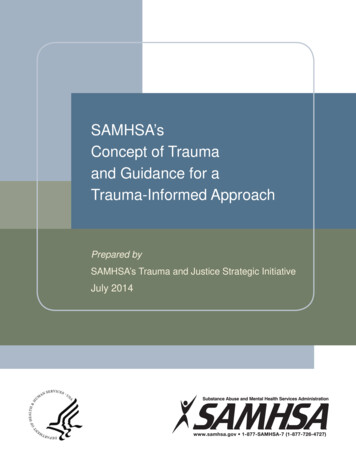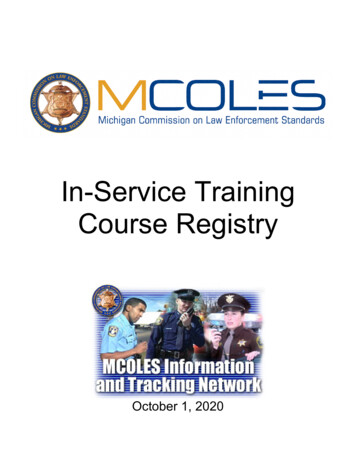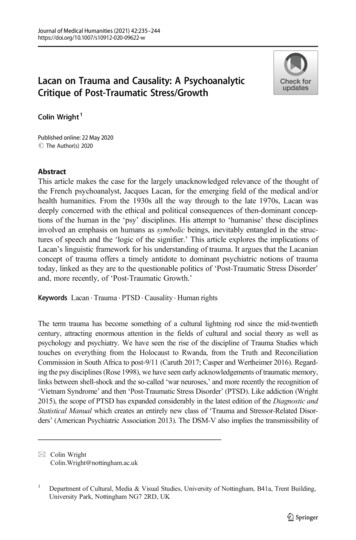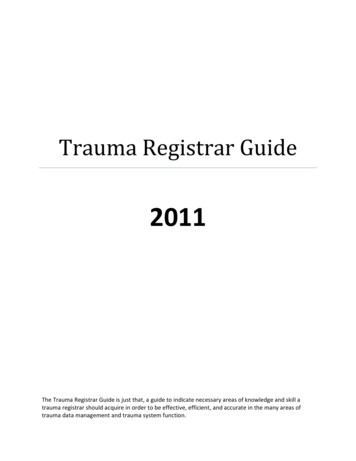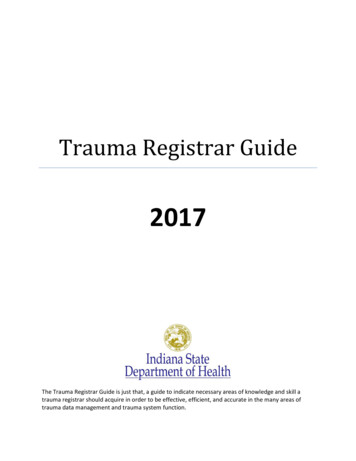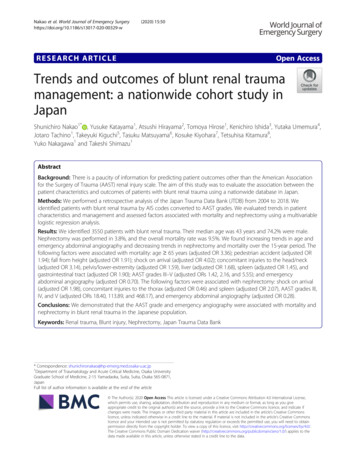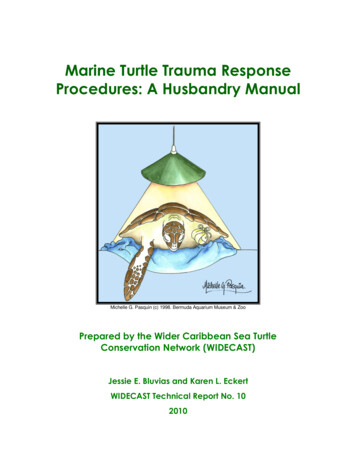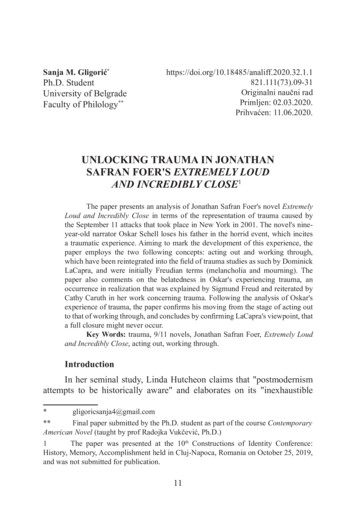
Transcription
Trauma Registry TrainingExercisesDee VernbergDan RobinsonDigital Innovation785-296-0613785-296-3180(800) 344-3668 ex 4www.kstrauma.orgFor a copy of the Data Dictionary, please follow the maDataDictionary.pdf1
Table of ContentsQuestion1.How many spinal cord injuries in registry?Answers (pp.19-21)Question2.How many spinal cord injuries have neurologic deficits?Answers (pp. 21-23)Question3.How many spinal cord injuries were transferred out?Answers (pp.24-26)Question4.How many trauma calls do you have per month?Answers (pp. 27-29)Question5.How many trauma calls per month were treated by anOrthopedic surgeon?Answers (pp.30-31)Question6.How many trauma surgical cases do you have per year?Answers (pp. 31-33)Question7.What percent of your trauma patients sustained blunt injuries?What percent of your trauma patients sustained penetrating injuries?What percent of your trauma patients sustained thermal injuries?Answers (pp.33-36)Question8.TablesISS by #, Admitted to trauma service, deaths, % mortality (from admitted to trauma service)ISS by #, all deaths, #trauma calls, %mortality from trauma calls, % mortalityAnswers (pp. 37-51) (On p. 47 a solution to a problem with no data intraining image)Question9.ISS by #pediatric pts, pediatric deaths, trauma calls for pediatric patients%pediatric mortality (from trauma calls), % pediatric mortalityAnswers (pp.52-53)Question10.Grade spleen injury by # spleen injuries, # undergoing IR embolization,# splenorrhaphy, # splenectomyQuestion11.How many orthopedic operative procedures are performed within 24 hours?455555566712Question12.How many complex and pelvis and acetabular cases were performed in the last year?13Question13.Total # ED disposition, ED disposition for admitted to trauma service14Question14.How many geriatric patients are admitted following a fall from standing152
PrefaceThis exercise manual is written for anyone who wants to learn Report Writer butis specifically written for Level III hospitals preparing for their American College of Surgeons (ACS) site visit. The questions were chosen to reflect the types of questions thatthe ACS might ask and to cover the range of basic functions that are used in reportwriter to analyze these questions.This document was written so that a person can teach him or herself how to usereport writer. Questions are listed and their solutions are presented by showingscreen shots from report writer and covering each step that must be completed. Thefinal solutions reflect findings from the training image data base. However, the solutionsdo not cover setting up the initial ACS filter query. This is covered in the overview document “Report Writer Training Guide: A Reference”.In preparing for an ACS visit, an analyst should allow plenty of time to analyzethe questions that are sent to the hospital prior to the visit. An analyst will need to befamiliar with the trauma registry data (e.g., variable names and options available in collector — know and use your Data Dictionary!); and to be comfortable using ICD-9 diagnosis codes, ICD-9 E-codes, procedure codes and AIS predot and post dot codes. Onthe other hand, no one can know everything so if you have a question, do not hesitate to call either the State Trauma Program Office or Digital Innovation for help withcoding questions. Registrars and Nurse Coordinators at the Level I and Level II hospitals are also a wonderful resource to use.It is recommended that you try to solve each problem sequentially as later questions presume that you know how to perform simple functions. For questions 1-9, thesolutions are presented starting on page19. The Table of Contents shows the pagenumbers where these solutions can be found. For questions 10-13, the solutions followthe question.One function that is NOT covered in this manual is downloading findings (results) intoExcel. This will be covered in a subsequent document.As with any data analysis program, the more you use Report Writer, the morefacile you will become. As you become more skilled, you may find that there could bemultiple ways to reach a solution. In the meantime, keep trying—ask questions and always test your answers by reviewing your cases.3
ExercisesThe exercises below are sample questions that the American College of Surgeons hasasked hospitals to answer during their site visit.Question 1. How many spinal cord injuries do you have in your registry?This problem requires that you define spinal cord injuries with a query. The most specificway to define spinal cord injury is with the AIS predot codes. See Appendix 1 for a copy ofthe AIS codes for the spinal region. When choosing your data elements in your query fromthe Anatomical Diagnosis tab, you will want to use the ANY(PREDOT Codes). Be sure anduse the Q option!Don’t use this data elementTo define spinal cord injury, you have to decide whether or not to include Nerve root or plexus injuries. For example do you want to includebrachial plexus injuries, cervical, thoracic or lumbar nerve root injuries,or cauda equina injuries? For this exercise, do not use nerve root orplexus injuries. Remember, Appendix 1 contains AIS–98 codes. The traumaregistry will begin using AIS –2005 in 2010. You will need newAIS predot codes to define spinal cord injuries when the registry begins using AIS 2005! Even if you don’t enter AIS predot codes in your registry, theyare there. Collector automatically maps AIS codes from ICD-9 diagnosiscodes when you click the tricode button.4
Question 2. How many spinal cord injuries have neurological deficits?For this exercise, do not include neurological deficits from nerve root orplexus injuries. You will need to decide whether or not to include theseinjuries for an ACS visit, though. This query will be a subset of the previous query. Use PREDOT CODES.Remember, Appendix 1 contains AIS–98 codes. The trauma registrywill begin using AIS –2005 in 2010. You will need new AIS predotcodes to define spinal cord injuries when the registry begins using AIS 2005!Assume that any cord laceration NFS would cause a neurologic deficit, butcord contusions NFS do not.Question 3. How many spinal cord injuries were transferred out?Question 4. How many trauma calls per month?For this question, you have to define trauma calls and figure out how to display the information by month. Defining trauma calls is a query. To have the number of traumacalls displayed by eda month, you have to use a gather for eda month.Question 5. How many trauma calls per month were treated by an orthopedic surgeon inthe ED? Which orthopedic surgeons took these calls?Question 6. How many trauma surgical cases do you have per year? For this question,define trauma cases using the ACS filter.Question 7. What percent of your trauma patients sustained blunt force injuries?What percent of your trauma patients sustained penetrating injuries?What percent of your trauma patients sustained thermal injuries?5
Question 8. Suppose you were asked to produce the following tableISSNumberAdmitted toTrauma ServiceDeaths% Mortality(from admittedto trauma service)0-910-1516-24 25TotalUnfortunately, our training image does not have any data to calculate admitted to trauma service. So .for this exercise, practice developing thetable below. In the answer section of this document, strategies for developing both tables will be presented.ISS# all patientsAll deaths# TraumaCalls% mortality % mortality(from traumacalls)0-910-1516-24 25TotalQuestion 9. Suppose you were asked to produce the following tableISS# allAll pediatricpediatric ptsdeaths# Trauma% pediatricCalls formortalityPediatric pts (from traumacalls)%Pediatricmortality0-910-1516-24 25Total6
Question 10. Suppose you were asked to produce the following table.Grade ofSpleen Injury# SplenicInjuries# Undergoing(IR)Embolization# of# splenectomysplenorrhaphyGrade IGrade IIGrade IIIGrade IVGrade VTotalYou will approach this problem the same way you did question 8. All you need todo is to create some new queries!Codes for Splenic Injuries—use ANY(PREDOT CODES)These are AIS 98 codes544210—contusion (hematoma) NFS544212—subcapsular, 50% surface area; intraparenchymal, nonexpanding, 5cm in diameter; minor; supterficial; (OIS Grade I or II).544214—subcapsular, 50% surface area or expanding;ruptured subcapsular or parenchymal; intraparenchymal 5cm in diameteror expanding; major (OIS Grade I or II).544220—laceration NFS544222 . simple capsular tear 3 cm parenchymal depth; no major (i.e., trabecular)vessel involvement; minor; superficial; (OIS Grade I or II)544224 . No hillar or segmental parenchymal disruption or destruction; 3 cmparenchymal depth or involving major (i.e., trabecular) vessels; moderate(OIS Grade III)544226 . Involving segmental or hilar vessels producing major devascularization of 25% of spleen but no hilar injury; major (OIS Grade IV)544228 . Hilar disruption producing total devascularization; tissue loss; avulsion;stellate; massive; (OIS Grade V)544299Spleen NFS544240rupture (’fracture’) NFSGrade I or II544212544214544222Grade III544224Grade of Spleen injury (Codes)Grade IVGrade IV5442265442287
Query for Spleen InjuriesTo create variable for Grade of Spleen InjuryCreate your coded variable for Gradeof spleen injury as shown below.Click theAdd buttonCodes for Spleen Grades can befound on the previous page & areshown below in column 2.Save thenclose8
Procedure Codes for Splenectomy41.2 Splenotomy41.43 Partial Splenectomy41.5 Total SpenectomyQuery for Total SplenectomyThis is a commaIf you want to include partial splenectomy, you can add41.43 to the list of numbers in column 2. Be sure andseparate procedure numbers with commas.Procedure codes forSplenorrhaphy41.42 Excision of lesion ortissue of spleen41.95 Repair & plasticoperations on spleenThis is the query for splenorrhaphyCreating a Query forIR embolization of thespleenThere is not a good procedure code for IR embolization of spleen since this isa relatively new procedure.You can use procedure code 38.86 (other surgical occlusion of vessels, abdominal arteries) OR 39.79 (other endovascular repair (of aneurysm) of other vessels—includes coil embolization or occlusion) for IR embolization. If you use these codes, you will need to review the patient charts to see if the patientsactually had of the spleen.9
Using your queries and coded variableCheck this boxUse your queries in setting up this report tableDon’t forget to put your ACS filter hereUse the coded variable in this gather1. Click the gather button to get this screen2. Click the “Data Element” Button4. Highlight & SelectSpleen Grade3. Select coded variable tab10
Type the name of this gatherThis is the coded variableClick “Save” then click “use”How to Set up the statistics report2. Name statistics re-*** 1. Be sure and check this boxUse CNTsubset hereThese are queriesSave and use11
Results of statistics report for spleen injuriesQuestion 11. How many orthopedic operative procedures are performed within 24 hoursof admission?Procedure codes for operations on musculoskeletal systemANY(PX PR) 76.01 to 84.99Use “each” b/c you want both orthopedicprocedures and performed in ORAny(PX LC) 2 indicates procedure was performed in OR* Add the ACS filter query to the 2 queries above usingthe “ADD” button.Save and useReport writer can NOT subtract dates (i.e. procedure state date/time—eda date/time); therefore, you will have to pull each of the records that meet the abovequery and review the dates and times.See p. 17-18 on how to do display patient records with a datatable.12
Question 12. How many complex pelvis and acetabular cases performed at this institution during the reporting year. If there are cases transferred out, explain.There are no data in training image for complex pelvis & acetabular fractures so nofinding are presented.Predot codes for complex pelvis and acetabular cases (AIS 98).AIS 98 does not capture these cases as well as AIS 2005.852606- Pelvis Fx with substantial deformation and displacement with associated vascular disruption or with major retroperitoneal hematoma “open book” fracture852608 same as above with blood loss 20% by volumeSave and use this query.Complex pelvis & acetabular fractures with theACS filterYou could refine this queryby running a data table report on the procedures thatthese patients received inthe OR. From this list ofprocedures, you couldchoose relevant surgicalcodes for repair of complexpelvic & acetabular fractures to measure casestreated at your hospital.Gather by dis to to see ifany complex pelvic fracturecases were transferred toan acute care facility. (ORyou can add a query ANY(PX LC 2) (Any procedure performed in Ort to the query above) Besure and check cases)This query has the ACSfilter includedThe cases not transferredout (dis to 7) shouldhave been treated at yourinstitution IF you only usedis to 7 as acutely transferred to another hospital.Review the cases of dis tonot equal to 7 to see if thisis the case. You wouldalso want to reviewdis to 7 to make surethere was not a case thatwas treated but dischargedto an acute care facility.13
Question 13. Complete the following table for trauma patient admissions. Remember:your ACS filter will give you only trauma admissions.Distribution from ED (Trauma patient admissions)ED DispositionTotal numberED to OR104 (training image #’s)ED to ICU6 (training image #’s)ED to Floor27 (training image #’s)Total137 (training image #’s)Be sure and click “user”Admitted to TraumaServiceRun this report to get#’s for the total number of trauma admissions (using the training image)There is nodata in thetraining image for trauma service. See pp. 4751 to see how toanalyze traumaservice.How to set up report “ED dischargeThese are queries14
Question 14. How many geriatric trauma patients (age 65 years old) are admitted following a fall from standing?Use the following e-codes (Any (E CODE ) to define falling from standing. (constructa query).885.9 Fall on same level from slipping, tripping, or stumbling—fall from other slipping, tripping, or stumbling.888 Other and unspecified fall (fall on same level NOS or accidental fall NOS)888.0 Fall resulting in striking against sharp object888.1 Fall resulting in striking against other object888.8 Other fall888.9 Unspecified fall*Note The 888 codes above are not specific are probably capture ONLY falls from standing. Therefore, you may want to review your records after you count.Query for fall from standingFirst, construct aseparate query forfall from standingand for age 65.Next, (on followingpage, combinethese queries).Query for geriatric patients15
This is how you combine the two queries you just made and the ACS filter.2. Give this new query a name &descriptionThese are queries so Noinformation in operator orcolumn 2.Don’t forget the ACS filter!Use “each” because you want fallsand pts. 65 years old.1. Use‘add’ toinsertqueries.The ACS filter only includesadmitted patients.Save and useUse “count” ifyou only have aquery1.Specify records or time period you want to analyze2. Click OK16
If you wanted to pull the records from the results you found from the count on the previous page, run a report with patient name, trauma number & medical record number.Make sure toclick “user”Click report,then click “Add”Click “Data Table Report”Name & specify tableThese are variables from thedata element list1. Click “add”then “field” andchoose variables from thedata elementlist.2. click OKDo this 3 timesClick “save” & “use”17
Click “Runsince this isa reportSpecify records or time periodClick OK18
Answers to exercises 1-9Question 1. Consider using this query to extract spinal cord injuries in your registry. Thisquery does NOT include plexus and nerve root injuries. Remember to save your querybecause you will need to use this with the ACS filter.Use “one or more” here because anyof these codes are valid.Save your spinal cord query, then click use. Clear this query. Then create another query thatwill combine your ACS filter and this spine query. Why? Because the Spine query has an ORstatement between the predot definitions, and this query will use the each feature. Remember,for ACS visits, you have to include the ACS filter to answer most questions.Click save beforeclicking the “use”Use “each” because you wantto include both the ACS filter &spinal cord queries.19
You are now ready to count the number of spinal cord injuries that meet ACS criteria!Since you have a query, you use the count button.You can specify a count either with arange of trauma numbers or with arange of EDA arrival dates. This queryselected 2, so the number of spinalcord injuries meeting ACS criteria willhave eda arrival dates between01/01/1980 and 12/31/2099. You canchange this range before you count.Once you click o.k. , you will get thecount.It may be hard to see, but thiscount shows that you have 10patients with spinal cord injuriesthat meet ACS criteria.20
1. (continued) Suppose you wanted to include nerve root and plexus injuries in your definition of spinal cord injuries. You would use the following AIS predot codes for defining spinalcord injuries. And spinal cord injuries with neurologic deficits The nerve root and plexus injuriesare underlined.Spinal Cord injuryThe nerve root and plexus injuries ( PREDOT Codes) are underlined. Include all the codes listed below if you want to include nerve root & plexusinjuries in your spinal cord injury definition.640200 to 640276 (Cervical cord contusions and lacerations630260 to 630266 (Cervical nerve root injuries)630210 to 630226 (Brachial plexus specified injuries)630299 (Brachial plexus injury NFS)640400 to 640468 (Thoracic cord contusions and lacerations)630402 to 630499 (Thoracic nerve root injuries)630600 to 630638 (Cauda equina injuries)640600 to 640668 (Lumbar cord contusions and lacerations)630660 to 630699 (Lumbar nerve root injuries)Question 2. (answer) Queries for spinal cord injuries with neurologic deficits.Nerve root & plexus codes in red. Do not use the codes that are underlined below for this exercise.Spinal Cord injury with neurological deficitsCodes with nerve root and plexus injuries ( PREDOT Codes)640210 to 640236 (Cervical cord contusion with incomplete/complete cord syndrome.640242 to 640276 (Cervical cord laceration with incomplete/complete cord syndrome)640240 (Cervical cord laceration NFS—include this code because laceration to spinalcord is clinically considered to have some type of neurological deficit)640410 to 640428 (Thoracic cord contusion with incomplete/complete cord syndrome)640442 to 640468 (Thoracic cord laceration with incomplete/complete syndrome)640400 (Thoracic cord laceration NFS—include because lacerations are consideredclinically to have neurologic deficits)640610 to 640629 (Lumbar cord contusions with incomplete/complete cord syndrome)640642 to 640668 (Lumbar cord laceration with incomplete/complete cord syndrome)640640 (Lumbar cord laceration NFS—include this code as any laceration is clinicallyconsidered to have neurologic deficits)630620 to 630638 (Cauda equina syndrome with neurologic deficit)21
Question 2 Answer (continued). Use the following query if you do not include nerve root orplexus injuries in defining spinal cord injuries with neurologic deficits. Remember to save anduse this query with the ACS filter. To find the number of patients with spinal cord injuries withneurologic deficits use the count button.Making another query with two saved queries. Save and use this query.22
Use the count button to obtain the number of spinal cord injured patients with neurologicdeficits. You may specify the eda time period for these patients when you click the countbutton.Specify the patients you want to analyze inthe blue box to the left, Click o.k. to get yourresults.As you can see below, you have 7 patientsthat had spinal cord injuries with neurologicdeficits. (T
Remember, Appendix 1 contains AIS–98 codes. The trauma registry will begin using AIS –2005 in 2010. You will need new AIS predot codes to define spinal cord injuries when the registry begins us-ing AIS 2005! Assume that any cord laceration NFS would cause a neurologic deficit, but cord contusions NFS do
